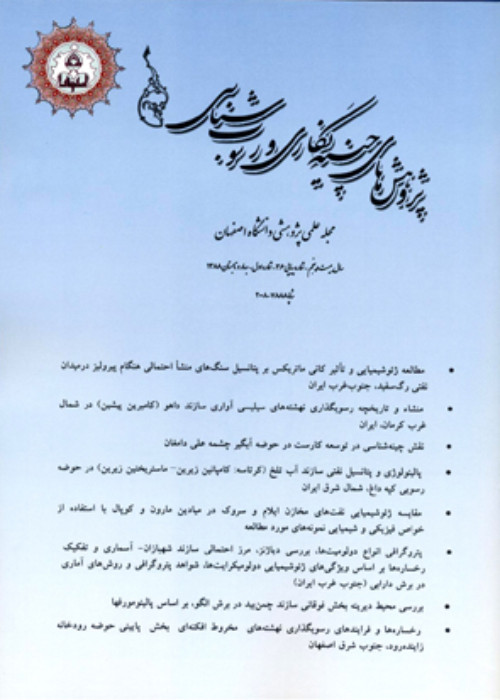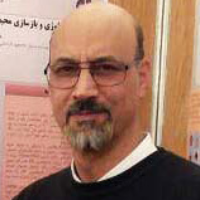Palaeoenvironmental study and sequence stratigraphy of Sanghaneh Formation in Qalehjegh section (North of Bojnord) using organic matter contents of the rock unit
Author(s):
Abstract:
Introduction
Kopeh-Dagh basin is located northeast of Iran and in this basin the sedimentary beds began from middle Jurassic. The Sanghaneh Formation is one of the lower Cretaceous rock units in sections. One of the important fossils group are palynomorphs that described very abundant in this formation. Dinocysts diversity on this formation is more than other palynomorph groups. Palynological studies are done by keshmiry et al. (2014), davtalab et al. (2007) and etc. This formation here is laying on Sarcheshmeh Formation and is covered by Aitamir Formation. The age of this formation in the Qalehjegh section based on the dinoflagellate assemblage, is Late Aptian – Early Albian. Purpose of this research is palaeoenvironmental study base on palynofacies interprets and to separate sedimentary sequence Kopeh-Dagh sedimentary basin. Qalehjegh section is located between 57 ˚ 23 ’ 03” E and 37 ˚ 43 ’ 17” N. The formation comprises mainly calcareous shale and shale with siltstone and interlaminations of limestone and argillaceous limestone. The Sanghaneh Formation is studied base on several group of fossils in other using organic matter contents of the rock unit. Material and Methods
For palaeoenvironmental and sequence stratigraphy purposes, 127 rock samples collected from the formation and prepared in the palynology laboratory.Standard preparation methods were used (Traverse 2007). Cold hydrochloric (30%) and hydrofluoric (30%) acids were used to dissolve carbonates and silicates. No oxidants or alkalis were used. The residue was neutralized and centrifuged in ZnCl2 (specific gravity 1.9), then sieved at 20 µm using a nylon mesh, and mounted on microscope slides using liquid Canada balsam and then the slides were examined in the transmittal microscope. Discussion of Results & Conclusions
Palaeoenvironmental interpretation: Three main groups of sedimentary organic matter (SOM) can be distinguished: (1) amorphous organic matter (AOM), (2) phytoclasts including black and translucent matter and (3) palynomorphs including (dinocysts, acritarchs, foraminifera linings, spores and pollen grains). Compositional changes in palynofacies are useful in palaeoenvironmental interpretations of sedimentary rocks (Tyson, 1993). The results of all are plotted on an AOM– Phytoclasts–Palynomorphs ternary diagram after Tyson (1995). Studying Sanghaneh Formation in Qalehjegh section based on the three major groups of organic matter debris found in palynology slides (Palynomacerals or Phytoclasts, Marine Palynomorphs and Amorphous Organic Matters), four types of palynofacies were recognised: palynofacies II: Marginal basin, III: Proximal shelf, IV: Shelf to basin transition, V: Distal shelf. Pf1: This palynofacies is marked by an increase in phytoclasts content (65-90%) compared to palynofacies III and IV, and low frequency of marine palynomorphs (5-15%) and AOM (5-25%). AOM diluted by high phytoclast input, but AOM preservation moderates to good. Generally low AOM preservation. This facies was represented Marginal dysoxic - anoxic basin. It represents type II kerogen of Tyson. This palynofacies was recognised in samples 1058, 1053, 1040, 970, 963, 918, 907, 820, 808, 772, 762, 759, 750, 744, 4946, 4944, 4907, 4894 and 4892. Pf2: This facies is characterized by high phytoclasts (50-80%), low AOM (5-15 %) and common marine palynomorphs (15-45%). This facies was represented Heterolithic oxic shelf ("proximal shelf") and it was represented type III kerogen of Tyson (1993). This palynofacies was founded in samples 1036, 1012, 991, 987, 983, 978, 974, 952, 942, 931, 922, 910, 904, 899, 897, 885, 859, 841, 833, 830, 827, 816, 810, 791, 781, 766, 756, 5012, 5007, 5005, 5003, 5000, 4998, 4991, 4980, 4942, 4928, 4926, 4922, 4920, 4916, 4914, 4909, 4888, 4884, 4882, 4878, 4872 and 4870. Pf3: This is characterized by low marine palynomorphs (10-25%), 4-45% AOM and a predominance of phytoclasts 40-80% of the total particulate organic matter [POM]). The facies is proportionate with fourth palynofacies (IV) of Tyson (1993). This facies is represented Shelf to basin transition and it was recognised in samples 1061, 1042, 1032, 1028, 1027, 1017, 1004, 966, 950, 948, 945, 934, 881, 877, 874, 869, 855, 851, 845, 838, 813, 806, 802, 794, 774, 5016, 5014, 5010, 4994, 4989, 4975, 4966, 4948, 4940, 4932, 4924, 4918, 4912, 4898, 4896, 4890, 4886, 4880 and 4874. Pf4: This facies is characterized by a moderate to high abundance of Marine palynomorphs (30–70%), a moderate abundance of phytoclasts (20–45%) and a low to moderate abundance of AOM (5–30%). Rising of marine palynomorphs depends to offshore condition. The facies is proportionate with fifth palynofacies (IV) of Tyson (1993) and it represented distal shelf sedimentary environment. This palynofacies was founded in samples 1024, 1020, 1008, 955, 939, 894, 889, 879, 865, 788, 786, 4959, 4938, 4903 and 4901. Federova (1977) and Duringer & Doubinger (1985) have used plots of spores, pollen, and microplankton in a ternary diagram to indicate general depositional environments and associated regressive-transgressive trends. This ternary is considered here as a useful tool for recognizing and indicating the possible depositional environments and changes in trends of marine sedimentation. Based on this plot, sedimentary environment of Sanghaneh Formation recommended as from shallow marine (neritic) to offshore (moderately deep). Assimilating palynofacies with palynology plot data, sedimentary environment setting of the formation on Qalehjegh section is recommended shelf area and with a suboxic-dysoxic conditions. Separating sequences of the Sanghaneh Formation: One of approach in sequence stratigraphy is using from palaynologycal agents. In this study is used almost some agents of palynology to separate sequences. The palaynologycal agents used here is inclusive: phytoclacts percentage, opaque phytoclasts percentage, brown phytoclasts percentage, opaque to brown phytoclasts ratio, cubic to lath opaque phytoclasts ratio, AOM percentage, terrestrial palynomorphs absolute abundance, marine palynomorphs percentage and dinocysts diversity. In Transgressive System Tract (TST) is increased marine palynomorphs (Leckie et al. 1992), AOM (Tyson 1993), dinocysts diversity (Habib 1982) and lath opaque phytoclasts contents. In contrast in this systems tract phytoclasts contents (Tyson 1993) and terrestrial palynomorphs are decreased (e.g. Habib 1982). But from TST to Highstand System Tract (HST) is descended marine palynomorphs, AOM, dinocysts diversity and lath opaque phytoclasts contents and phytoclasts, terrestrial palynomorphs and cubic opaque phytoclasts contents is ascended. In sequence boundary brown phytoclasts content and terrestrial palynomorphs are abundant (Tyson 1993) and in maximum flooding surface (mfs) opaque phytoclasts contents and marine palynomorphs are most abundant (Habib 1982). Based on palynofacies analysis tree genetic stratigraphic sequences (A, B and C) w ere recognized. Genetic sequence A is extended until depth of 0-720 m. In this sequence TST started may be is part of the Sarcheshmeh Formation until depth of 350 m, and HST was begun from depth of 350-720 m. Genetic sequence B is bounded by the sequence boundary A (Sb1) and the sequence boundary B (Sb2). It is started form depth of 720-1350 m. HST and HST is placed from 720-1140 and 1140-1350 m. Genetic sequence C is bounded from down by the sequence boundary C (Sb3) and up boundary is not distinct.In this sequence TST is started from depth of 1350-1600 m and HST is started from 1600 m and continues to end of the formation. Studying the Sanghaneh Formation in Qalehjegh section based on the three major groups of organic matter debris found in palynology slides, four types of palynofacies were recognized: II, III, IV and V. According to palynofacies analysis, the formation depositional setting varies from shallow to moderately deep environment under suboxic-dysoxic conditions. In the interpreted palaeoenvironment using ternary palynomorph plot, it is recommended that sedimentary environment of the formation is shallow marine to offshore. Statistical studies on palynofacies factors and palynomorphs plot represent sedimentary environment setting of Sanghaneh Formation in Qalehjegh section as a shelf area with suboxic-dysoxic conditions. Similarly the stratigraphic analysis of palynofacies changes led to the separation of three sequences with their boundaries.Keywords:
Language:
Persian
Published:
Stratigraphy and Sedimentology Researches, Volume:31 Issue: 3, 2015
Pages:
69 to 82
magiran.com/p1453304
دانلود و مطالعه متن این مقاله با یکی از روشهای زیر امکان پذیر است:
اشتراک شخصی
با عضویت و پرداخت آنلاین حق اشتراک یکساله به مبلغ 1,390,000ريال میتوانید 70 عنوان مطلب دانلود کنید!
اشتراک سازمانی
به کتابخانه دانشگاه یا محل کار خود پیشنهاد کنید تا اشتراک سازمانی این پایگاه را برای دسترسی نامحدود همه کاربران به متن مطالب تهیه نمایند!
توجه!
- حق عضویت دریافتی صرف حمایت از نشریات عضو و نگهداری، تکمیل و توسعه مگیران میشود.
- پرداخت حق اشتراک و دانلود مقالات اجازه بازنشر آن در سایر رسانههای چاپی و دیجیتال را به کاربر نمیدهد.
In order to view content subscription is required
Personal subscription
Subscribe magiran.com for 70 € euros via PayPal and download 70 articles during a year.
Organization subscription
Please contact us to subscribe your university or library for unlimited access!



